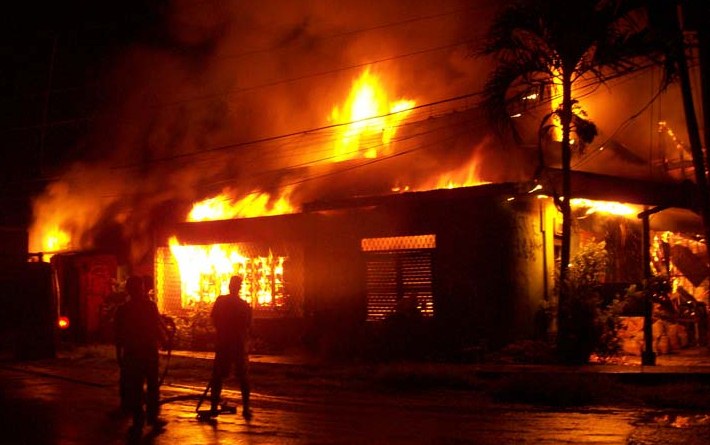
Online Exclusive: Courting Disaster in Nightclubs
Wrightstyle is a specialist in designing, fabricating and installing steel and glass systems for both internal and external applications. The company’s systems have been installed in commercial and public sector projects internationally. Director Jane Embury reports on several needless nightclub tragedies and on lessons learned.
- By Jane Embury
- Apr 09, 2013

Nightclubs are designed as places where large numbers of mainly young people can get together, socialize, dance and have fun. They’re also supposed to meet fire safety regulations and provide a safe environment. But nightclubs can be anything but safe.
Earlier this year the Kiss nightclub in Santa Maria, Brazil was engulfed in flames when a flare set off by a band playing at the venue set fire to soundproofing in the ceiling. To make things worse, the burning soundproofing then generated toxic fumes, including cyanide, turning the club into a gas chamber. Some 240 young people died.
Kiss Nightclub: The Aftermath
Initial investigations found that the club was operating under an expired safety licence and there were too many people in the venue. On top of that, apart from having a pyrotechnic display indoors, fire extinguishers weren’t working properly.
It was tragically similar to another nightclub fire ten years earlier, this time in Rhode Island, New Jersey. This happened at The Station nightclub and again was started when pyrotechnics set fire to flammable soundproofing material in the walls and ceiling.
The fire, as with the Brazilian inferno, took hold in minutes and killed 100 people. A further 230 people were injured. Once again, exits were flooded with people trying to escape – most ignoring alternative exits to head for the one exit they knew: the entrance at which they had arrived.
Again, a contributing factor was that the club was full beyond its authorized capacity. A National Institute of Standards and Technology (NIST) investigation found that a sprinkler system would have contained the fire. The nightclub was supposed to have had one; it didn’t.
The venue’s two owners and the band’s manager, who was responsible for setting off the pyrotechnic, were imprisoned – although all three have now been released – while new sprinkler requirements and fire code provisions enacted as a result remaining in place in Rhode Island and across the United States.
Station Fire
It may be obvious, but indoor pyrotechnics are rarely a good idea. In December 2009, they were used at a nightclub in Perm, Russia and left over 150 dead.
The Station fire was the deadliest in the U.S. since a 1977 fire in Southgate, Kentucky claimed 165 lives. More of that fire later. However, the worst nightclub fire happened during World War II at the Cocoanut Grove in Boston when 492 people died.
It was 1942 and a young US soldier had taken his date to the nightclub. Seeking some privacy he removed the light bulb on their table but, when it was reconnected by a member of staff who had to light a match to see better, he accidentally set fire to decorative palm fronds, which rapidly led to flashover. Nearly 500 people died.
It remains the world’s worst nightclub fire and, apart from a lack of fire exits and other safety features, the enormous loss of life was greatly exacerbated by fire and toxic fumes spreading unchecked to upper levels of the club. The lessons learned formed the basis of new fire laws, the creation of several national fire safety organizations, and helped influence building safety in many other jurisdictions internationally.
The Top 10 deadliest nightclub incidents are:
Cocoanut Gove, USA, 1942
Deaths: 492
Dance hall, Luoyang, China, 2000
Deaths: 309
Kiss, Brazil, 2013
Deaths: 239
Rhythm Club, Natchez, Mississippi, USA 1940
Deaths: 207
Cromagnon Republic Club, Argentina, 2004
Deaths: 194
Beverly Hills Supper Club, Kentucky, USA, 1977
Deaths: 165
Ozone Disco Club, Quezon City, Philippines, 1996
Deaths: 160
Lame Horse, Perm, Russia, 2009
Deaths: 154
Club Cinq, France, 1970
Deaths: 143
Station nightclub, Rhode Island, USA, 2003
Deaths: 100
Of course, fires in nightclubs – as anywhere – can have a variety of ignition sources, usually something insignificant such as a dropped cigarette or faulty wiring. (The French nightclub tragedy, for example, Number Nine on our list, was started by a carelessly discarded match). However, a common thread running through all of these fires was how quickly each one of them took hold and spread, giving little time for people to escape.
After many of them, different lessons were learned and incorporated into new or updated fire regulations. However, one nightclub fire stands out as a prime example of everything bad: bad building design, bad fire safety procedures and bad enforcement – a perfect storm of small deficiencies that, together, added up to a recipe for disaster. It should still provide lessons for today’s architects, fire safety specialists and building managers.
The 1977 fire, Number 6 on our list, was at the Beverly Hills Supper Club in Southgate, Kentucky, which began from a spark from faulty wiring. That small and insignificant fault left 165 people dead. It was found that, as with the Kiss and Station disasters, the venue was hugely overcrowded. The total occupancy of the venue was estimated at some 2,750 people, which under Kentucky law required some 28 exits. The club only had 16 exits.
Beverly Hills Supper Club
In addition, not only were many of those exits not clearly marked but, because of the building’s poor design, they could not easily be accessed. Some exits could only be reached by passing through several different areas. Many victims were found in dead-end corridors, having become disorientated and lost.
A governor’s report into the fire called the club’s wiring an “electrician’s nightmare” and cited multiple code violations. Another report was also scathing, suggesting that the wiring could not ever have been properly inspected. That lack of inspection seems to have extended to the regulatory authorities, with the local fire department being accused of knowing about the venue’s fire safety failings, but not ordering any remedial work.
There were other code violations. There was no sprinkler system, no audible and automatic fire alarm, and several doors were locked.
The perfect storm was completed by poor building design. It had inadequate roof support and was built using flammable materials. However, of particular importance, it lacked firewalls or any form of containment. The fire was able to draw in oxygen in abundant supply and spread unchecked, with devastating effect.
Today, it is internal curtain walling that provides the fire safety design solution, allowing a large internal space such as a nightclub to be segmented into separate and discreet areas, so that if a fire does happen, it can be contained within one place, allowing everyone to escape.
Containing fire is what Wrightstyle glazing systems are designed to achieve, being a provider of integrated fire-rated steel and glass glazing systems for international markets – everything from external curtain walling to internal screens and doors.
Our systems are increasingly being specified internationally for shopping centers, offices, schools, hospitals, railway stations, anywhere that large numbers of people congregate and where fire and building regulations are most stringent.